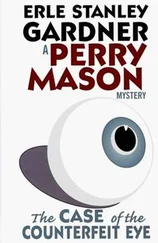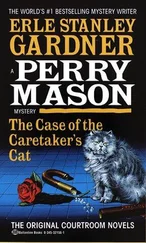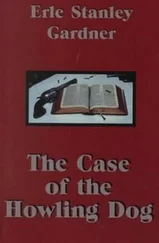“There was.”
“What did Mr. Mason say?”
“He suggested that I make an inspection of the swimming pool.”
“And you did this?”
“Yes.”
“And what did you find?”
“Nothing.”
“Then what happened?”
“Then Mason suggested that I had not looked far enough or hard enough.”
“You gathered the impression from what Mr. Mason said that in some way he was familiar with the hiding place which you subsequently discovered and wished to direct your attention to it?”
“Just a moment,” Mason said. “That question is argumentative; it calls for a conclusion of the witness. It is, moreover, incompetent, irrelevant and immaterial.”
“The objection is sustained,” Judge Fisk said. “Surely, Mr. Prosecutor, you don’t need to direct the attention of this witness as to his conclusions. Let him show what he did, what he found.”
“Yes, Your Honor,” Ormsby said, glancing at the jurors to make certain they had got the point.
“Let me put it this way,” Ormsby went on, as though baffled by the technical barrier put up by the Court but patiently desiring to get an important matter before the jurors, “you did complete a survey of the swimming pool?”
“I did.”
“And found nothing?”
“Nothing.”
“Then you made a second search.”
“Yes, sir.”
“And at whose suggestion was that?”
“The suggestion of Mr. Perry Mason.”
“Now, by Perry Mason, you mean the attorney who is at present representing the defendants in this action.”
“Yes, sir.”
“And what did Mr. Mason say — if anything?”
Ormsby got up from his chair and stood waiting for the answer, emphasizing the question by his action, and also emphasizing the answer Lieutenant Tragg was about to make.
Tragg said, “Mr. Mason suggested that I look behind the steps of the swimming pool.”
“Behind the steps of the swimming pool,” Ormsby repeated.
“Yes, sir.”
“And you did so?”
“I did so.”
“And what did you find?”
“As soon as I looked behind there, or, rather, as soon as I groped behind there with my hand, I felt a small metal ring.”
“And what did you do?”
“I inserted my finger in that ring and pulled gently.”
“And what happened?”
“I could immediately feel that this ring was at one end of a flexible, metallic cable which was running over a roller.”
“And what happened then?”
“I pulled the ring a matter of some two or three inches, which released a catch on the inside of a receptacle some ten feet back from the swimming pool.”
“And then what happened?”
“A spring raised up a section of tile about eighteen inches square, disclosing a cleverly concealed hiding place measuring sixteen and one-quarter inches square, and two feet, three and a half inches deep, lined with steel and containing an automatic spring catch so that when the tile was pushed down the catch would automatically lock on the tile, holding it in position.”
“The tile was hinged on one end?”
“Yes, sir.”
“And what, if anything, did you find in this steel-lined receptacle?”
“Nothing.”
“Nothing?”
“That is right. Absolutely nothing.”
“And did Mr. Mason try to register surprise when you discovered this ring in the place which he had so insistently pointed out?... Well, I’ll withdraw that. I beg the pardon of Court and counsel. As I think it over I realize that question is improper. I just want to make sure, however, Lieutenant, that I understand your testimony correctly. You found this ring in a place that was indicated by Mr. Mason?”
“He indicated that I search there.”
“And that was after you had previously explored the swimming pool and found nothing.”
“Yes, sir.”
Ormsby strode over to the counsel table where Mason was sitting, bent slightly forward and said, “I just want to show you, if you want to grandstand to this jury I’ll meet you halfway.”
“Go right ahead,” Mason said in an undertone.
“Now then, this tile was pushed up by a spring?” Ormsby asked.
“It was.”
“Where was that spring?”
“It was a coil spring, as we subsequently discovered, which had been inserted so that it was around the steel rod which served as an axis on which the hinge revolved. Now, that’s not expressed very clearly, but the point is this tile was hinged. A half-inch steel rod ran through the hinge and furnished the pivot on which the hinge was raised. This steel spring, or coil spring, was twisted around the ends of this rod and was on a sufficient tension so that whenever the catch was released the tile raised up.”
“This tile, I take it, was the same in appearance and dimensions as the other tiles?”
“It was identical with the other tiles, except for the fact that a hole had been drilled in the tile, a metal insert had been placed in this hole to give it reinforcement and cemented in place. Then the steel rod which acted as an axis on which the tile revolved was inserted in this piece of cemented pipe so that the whole constituted a very rugged hinge.”
“And there was a spring so that the lid came up when the wire was pulled?”
“Yes, sir.”
“And how could this tile, this hinged tile you have referred to, be closed?”
“Only by physical pressure sufficient to overcome the tension of the spring.”
“Was this tile arranged so that it was virtually impossible to detect that it was different from the others?”
“It was a very cunning piece of work,” Tragg said. “Even after we knew that there was a hinged tile there it was possible to stand on it or walk on it and have no inkling of what lay beneath. The hinge was so carefully constructed and the spring catch was so mechanically perfect that there was absolutely no give or sway to the tile or anything to indicate that it wasn’t embedded firmly in cement.”
“And the receptacle was waterproof?”
“It was waterproof.”
“How was this waterproofing arranged?”
“By a piece of sponge rubber covered with tape which surrounded the lower side of the lip of the hinged tile.”
“So that any person pushing this hinged tile back into place would be very apt to place fingertips on this tape?”
“Yes, sir.”
“And, once raised, the tile had to be pushed back into place in order to close it. Is that right?”
“Yes, sir.”
“Now then, did you find any latent fingerprints on this tape which surrounded the lip of the tile or did you find any fingerprints on the interior surface of the tile — now mind you, Lieutenant, I am asking you about the interior, not the exterior — or in the interior of the steel-lined receptacle?”
“I did.”
“Did you discover latent fingerprints which could be deciphered?”
“I did.”
“And you developed those latent fingerprints and photographed them?”
“I did.”
“You subsequently took the fingerprints of various persons whom you felt might have had access to this receptacle or to the premises on which the receptacle was located?”
“Yes, sir.”
“And, by making comparison, were you able to determine who had made some of these fingerprints?”
“Yes, sir.”
“Whose fingerprints were they?”
Tragg swiveled in the witness chair so that he was looking straight at the jurors. “Two of the persons who had made fingerprints on the inside surface of the tile and on the tape were the defendants, Vivian Carson and Morley Eden.”
“You mean that you found both of their prints there?”
“I found both of their fingerprints.”
“Do you have photographs of those latent prints, and photographs of the fingerprints of the defendants?”
Читать дальше












